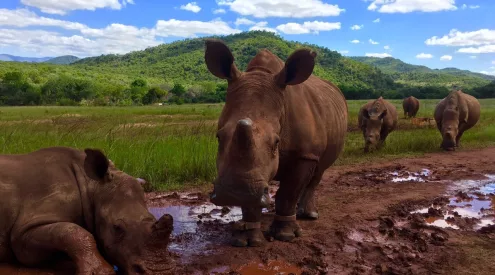A tiger from Gaza survived drone and grenade strikes, and nearly two months without food. He was even forced to live alongside his mummified partner. This is the story of a resilient cat and those that have given him a second chance at life.
Laziz strides along the baked South African turf, a chunk of meat dangling from his mouth, his coat catching the light as each muscular limb pads the ground. He appears healthy and strong, every inch the perfect tiger. It’s hard to believe the suffering that Laziz has endured.

Flash back to April 2015. The animal welfare group, Four Paws are responding to cries of help from a zoo in the south of Gaza, labelled the “worst zoo in the world” by the media. The scene that awaits the Four Paws team at Khan Younis Zoo are as horrifying as these reports would suggest.
Few animals survive. Those that cling to life are walking skeletons with zero food, scarcely any fresh water, and no access to veterinary care. The zoo is no longer able to pay the local animal keepers and the desolate enclosures are covered with garbage and debris. When the animals started to die, one by one, the owner mummified them, turning Khan Younis into a macabre museum.

The only big cat left is Laziz. His partner has been crudely mummified; her gnarled body sits spread-eagled in his enclosure. Laziz is severely malnourished and agitated; along with cohabiting with his deceased partner, he has seen grenades destroy his home and been without food for nearly two months.

Team members work swiftly to provide the necessary veterinary checks and load the surviving animals into their transport crates. “A special challenge was the tight time schedule we had available. And we were quite worried about whether Laziz would go into his transport crate without any issues; we definitely wanted to avoid anesthetising him if not absolutely necessary. But the tiger just went straight into the box as if he knew that he was going to a nice home. We were so relieved,” explains Dr Amir Khalil, the FOUR PAWS vet who led the mission.
A new life
Laziz was flown to Lionsrock in South Africa. Lionsrock has rescued more than 90 big cats from around the world, many saved from Wildlife Tourism Attractions. Wildlife Tourism is a $250bn per year industry, but these profits don’t come without costs. Up to 80% of venues mistreat animals and fail in basic animal welfare standards.
Big cats raised in captivity can’t be rehabilitated and released into the wild. However, the semi-wild enclosures of Lionsrock come a close second, providing safety and personalised care for animals with troubled pasts, like Laziz.

At Lionsrock, big cats have a lifelong home and appropriate habitat with which to roam. All enclosures are several hectares in size and feature open grassland with bushes and trees, and shelters that can be used as resting places. It is a world away from life at the world’s worst zoo.
Laziz is settling into life at Lionsrock and, despite bearing the scars of his past, is doing well. While many animals are scared of loud noises, Laziz – so accustomed to the sounds of war – gets spooked by silence. And although tigers are normally solitary animals in the wild, Laziz can get lonely and seek out the affections of other tigers.

For Dr Khalil it was en emotional first visit to see Laziz since the rescue. “It’s hard for us to understand what he has been through. He was exhausted when he arrived to Lionsrock – I don’t think he knew whether he was dead or he was alive. But after a few hours he started to relax and to realise…he is finally free.”

To learn more about Lionsrock and Four paws please visit lionsrock.org and four-paws.org.
Aaron Gekoski is an award-winning photojournalist who has been documenting the Wildlife Tourism industry for his project, Raise the Red Flag. To learn more please visit aarongekoski.com.




























